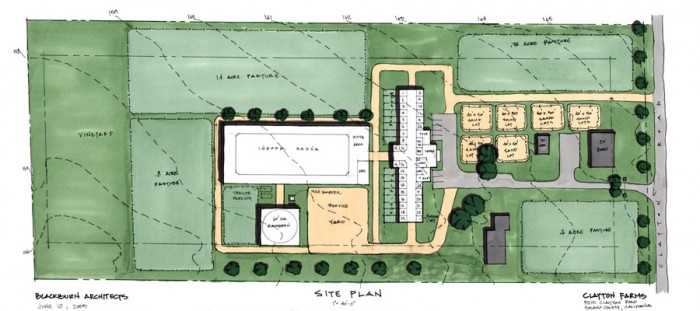This one comes from John Blackburn of FSC affiliate, Blackburn Architects:
One of our readers, Kelly, had a few great questions for me and I’d like to address two in today’s blog. (PS – Kelly writes a blog called Ride, Groom, Feed -the journal of a New Zealand Rider.) I hope my answers are helpful as it’s somewhat difficult to be specific since so much depends on your site, your program, and your goals. Thanks for your questions and for reading.
Q: “How can you allow flexibility for future development (that may never occur) without constricting the initial plans too much?”
A: Building for flexibility has its limits and you need to at least have a rough idea about how things might change in the future so you can plan for it in a reasonable and cost-effective way. Too much flexibility could ultimately end up adding to your costs, especially if the future needs are never realized. Here’s a couple of examples.
Regarding a site plan, say you want to build a 12-stall barn now, but may add or increase it to total 24 stalls later. I would recommend building a 12-stall barn with all of the horse stalls to one end so that you can add the future stalls to the other end to produce a 24-stall barn. That way the barn services (tack room, feed room, wash stalls, lounge/office, bathrooms) are all located to the center, where they are most efficient for a 24-stall barn. At the same time, if the services are at one end of a 12-stall barn, it’s still efficient for daily use.
Another example may be the question of where to build a barn and an outdoor arena with the idea that you’d like to add an indoor arena at some point in the future. A master plan can really help you to determine a phased build out of your entire program over time. If you do it once and take the time to fully plan for your entire potential program, you can determine the best placement for each structure and identify potential pitfalls to your site, understanding what can work best for your needs. There is no easy or simple explanation in this instance, but a master plan will help you (literally) visualize your success now and into the future.
Q: “I live in an area where it rains a lot. What are the most effective drainage solutions? Where should run-off water go? What kind of drains are the safest?”
Make sure the barn is on high ground and that all grade around the barn drains away from the barn. Same with paddock gates and lead paths. You can create storm drainage swales that lead to bio-retention ponds or back into the ground without eroding the surface soils. Safe drains depend on where they are located and their size. I try to avoid any conditions where a horse can step into or off a ledge and suffer a foot or leg injury. Use French drains where necessary to drain water into the soil without creating surface conditions that become or create hazards. Good site planning is critical and is another area where an experienced equestrian architect can provide a valuable service that the inexperienced architect does not have (and you will rarely receive from the design build or prefab barn builder).

